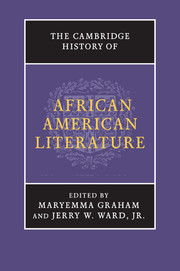Book contents
- Frontmatter
- Introduction
- PART I AFRICAN AMERICAN LITERATURE FROM ITS ORIGINS TO THE TWENTIETH CENTURY
- PART II AFRICAN AMERICAN LITERATURE IN THE TWENTIETH CENTURY
- 12 Foundations of African American modernism, 1910–1950
- 13 The New Negro Movement and the politics of art
- 14 African American literature and the Great Depression
- 15 Weaving jagged words: the black Left, 1930s–1940s
- 16 Writing the American story, 1945–1952
- 17 Geographies of the modern: writing beyond borders and boundaries
- 18 African American literature by writers of Caribbean descent
- 19 Reform and revolution, 1965–1976: the Black Aesthetic at work
- 20 History as fact and fiction
- 21 Redefining the art of poetry
- 22 Cultural resistance and avant-garde aesthetics: African American poetry from 1970 to the present
- 23 New frontiers, cross-currents and convergences: emerging cultural paradigms
- PART III AFRICAN AMERICAN LITERATURE AS ACADEMIC AND CULTURAL CAPITAL
- Bibliography
- Index
- References
12 - Foundations of African American modernism, 1910–1950
from PART II - AFRICAN AMERICAN LITERATURE IN THE TWENTIETH CENTURY
Published online by Cambridge University Press: 28 May 2011
- Frontmatter
- Introduction
- PART I AFRICAN AMERICAN LITERATURE FROM ITS ORIGINS TO THE TWENTIETH CENTURY
- PART II AFRICAN AMERICAN LITERATURE IN THE TWENTIETH CENTURY
- 12 Foundations of African American modernism, 1910–1950
- 13 The New Negro Movement and the politics of art
- 14 African American literature and the Great Depression
- 15 Weaving jagged words: the black Left, 1930s–1940s
- 16 Writing the American story, 1945–1952
- 17 Geographies of the modern: writing beyond borders and boundaries
- 18 African American literature by writers of Caribbean descent
- 19 Reform and revolution, 1965–1976: the Black Aesthetic at work
- 20 History as fact and fiction
- 21 Redefining the art of poetry
- 22 Cultural resistance and avant-garde aesthetics: African American poetry from 1970 to the present
- 23 New frontiers, cross-currents and convergences: emerging cultural paradigms
- PART III AFRICAN AMERICAN LITERATURE AS ACADEMIC AND CULTURAL CAPITAL
- Bibliography
- Index
- References
Summary
The map of African American cultural life during the first half of the twentieth century has always been organized around Harlem. From the late 1910s through the mid-1930s, the high water mark of what is variously known as the New Negro Renaissance or the Harlem Renaissance, the section of Manhattan spreading out from the axis of 125th Street and Lennox Avenue was the epicenter of an explosion of creative activity. Painters and poets, jazz musicians and blues singers, actors and orators, dancers and composers, poets, playwrights, and novelists all crowded the nightclubs, lecture halls, and salons, creating a ferment which justifies Langston Hughes's celebration of the era as a time when “the Negro was in vogue.” Attracting artists – a few of them white – from every corner of the United States and the African Diaspora, Harlem provided a laboratory where cultural traditions forged in response to slavery and the economic brutality of the post-Reconstruction era crashed up against “modernity,” the constellation of forces which had been transforming European and European American society and psychology at a steadily accelerating pace since the original Renaissance.
While what took place in Harlem illuminates the new aesthetic and political possibilities opened by that encounter, New York was only a part of a much larger story. Between 1910 and 1950, African American life was shaped by two major wars; a depression which redefined American political and economic life; the rise of a union movement with, at best, a mixed record on racial issues; the dawn of a Cold War and a Civil Rights Movement shaped in part by global politics; and, perhaps most centrally, what historians have termed the “Great Migration.”
- Type
- Chapter
- Information
- The Cambridge History of African American Literature , pp. 239 - 267Publisher: Cambridge University PressPrint publication year: 2011
References
- 1
- Cited by



